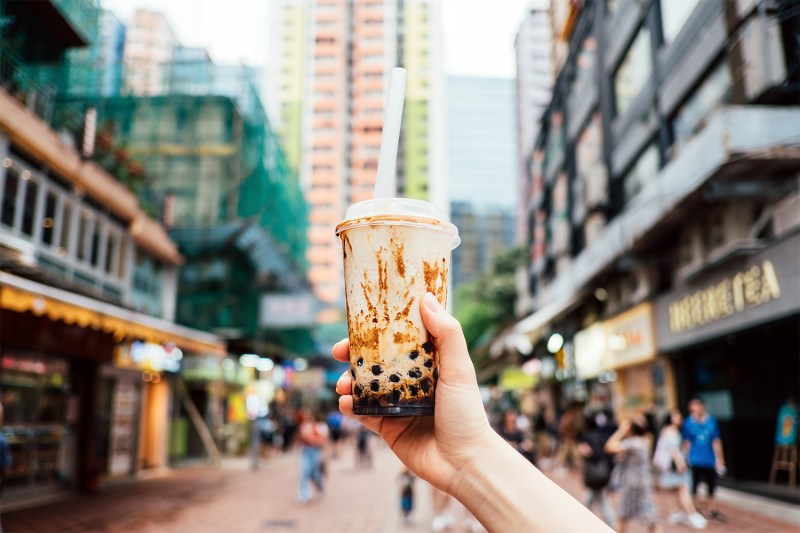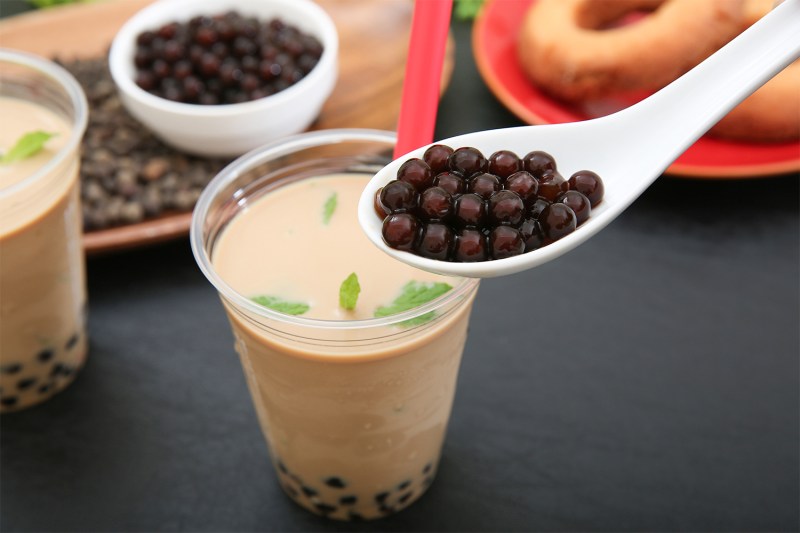
Bubble tea was born in Taiwan in the 1980s, though its inventor isn’t precisely known. According to the internet, there’s a tug-of-war between two probable genesis stories. The first involves the Hanlin Tea Room in 1986. The owner was moved by some tapioca balls he witnessed at the local market and opted to throw them in a tea drink. He added some brown sugar and honey, and the drink was born.
The other involves a tearoom on the other side of town. That shop’s owner was taken by Japanese cold coffee he enjoyed during travel and decided to apply what he witnessed to his tea. It was a hit, and the business grew. In the middle of a sleepy business meeting, a staffer added fen yuan (a kind of dessert pudding) to her iced milk tea drink and well, minds were blown.
While the latter story is better, both tales are decidedly tame. Especially for a caffeinated drink that has floating balls in it. I prefer to subscribe to a third, completely unfounded Genesis story. It involves an angsty teen, exhausted to see her parents having all of the adult fun with copious amounts of adult beverages. She decides to add some texture to her beloved tea and thinks some edible spheres are just the thing. A trend ensues.
Love or hate the stuff, bubble tea paved the way for an entire family of bizarre like-minded beverages. It’s (almost) fair to say that Orbitz existed almost solely because of the bubble tea phenomenon. The leopard-print-looking beverage has found a nice sturdy corner within the fun sector of the zero-ABV drinks market. And it deserves a better origin story.

Why bubble tea, you ask? For starters, because a large portion of the planet loves it. It’s serious business, with no signs of popping (pun intended). Bubble tea’s global implications were valued at around $2 billion in 2016 and it’s only grown in popularity since. It took a bit of time to find a footing in the U.S., but it’s around now, surfacing everywhere, from your local supermarket to your favorite high-end teahouse.
Bubble tea is, however, not for everybody. Siphoning tapioca balls (known as boba) through an oversized straw has its haters and defectors. There are even popping boba, by the way, juice-filled spheres that impart a meta element to the drink (remember Gushers?).
For clarity, it can go by a lot of names. Bubble tea is called everything from boba to pearl milk tea to tapioca tea. But the drink is generally the same, a green, black, or oolong tea hit with dairy or not, and then some sweeteners and those weird, edible orbs. It’s a whimsical way to enjoy an age-old beverage as well as add a little texture. When ordering, allow your tea shop to offer a suggestion. With a myriad of flavors and boba options, a good pairing can be a crapshoot.
Do consider the plastic footprint. As a portable drink, bubble tea uses a lot of the stuff, regrettably. But it doesn’t have to be that way. Think about enjoying it in-house or forfeiting the top and straw altogether (bobbing for boba, anyone?). Some outfits, like Float, even offer environmentally conscious containers. Or, make it at home and utilize your favorite thermos or cup. If you go straw, choose a recyclable straw.

Best bubble tea flavors
If you’re setting out to try bubble tea for the first time, here are some flavors to look for. There are a lot of flavors, so this is just a short list of our favorites.
Black milk tea
The original bubble tea flavor is perfect for those who appreciate the simple tea and tapioca combination. It’s sweetened with simple syrup or honey.
Strawberry
Strawberry is a classic and sweet choice, perfect for those who love berries. The tea base is usually black or green tea.
Brown sugar
This caramelized sugar flavor has a rich and complex sweetness. Brown sugar bubble tea is also known as brown sugar milk tea or tiger milk tea, but it doesn’t actually contain tea. Instead, it’s made with tapioca pearls, giving it a chewy texture and caramelized flavor.
Honeydew
Simply put, there aren’t enough opportunities in the drinks realm to enjoy the melon-y flavor of honeydew. It’s refreshing and fairly mild, allowing the tea component to come through.
Matcha
On top of the many health benefits of matcha, the Chinese green tea offers great color and flavor. Full and vegetal, it’s a taste all its own.
Lychee
The sweet Asian fruit was built for a refreshing boba. Grape-y and citrusy, it’s a nice complement to most milk tea bases.
Jasmine
If you can find it, order it. It’s floral and lasting and smells so good it will heal what’s ailing you.


